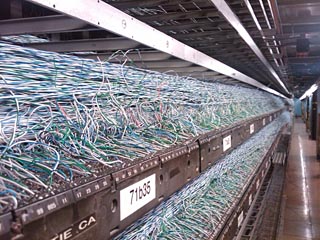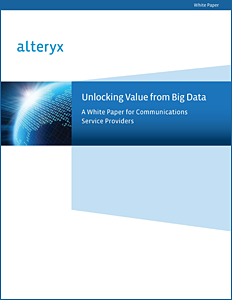 When the term “Big Data” was coined, it’s quite possible that they had the Communications industry in mind. From the moment that Alexander Graham Bell spoke the famous sentence “Mr. Watson—Come here—I want to see you” into the first telephone in 1876, the need to capture large volumes of data about the telecommunications network was born.
When the term “Big Data” was coined, it’s quite possible that they had the Communications industry in mind. From the moment that Alexander Graham Bell spoke the famous sentence “Mr. Watson—Come here—I want to see you” into the first telephone in 1876, the need to capture large volumes of data about the telecommunications network was born.
In the traditional, wireline days of the AT&T Bell Operating Companies, highly detailed records had to be kept about every piece of copper installed in the networks that were built across the United States, including where they started, where they ended, and which manholes they traversed. You also had to track what types of equipment were attached to each copper cable, as well as, which circuits were assigned to each cable.
 By the time I started working for New York Telephone/NYNEX (which became Bell Atlantic, then Verizon) in the 1990s, the huge filing cabinets filled with paper records had been largely replaced by AT&T’s Trunk Inventory Record Keeping System (TIRKS). TIRKS is a massive database that not only keeps track of every piece of copper, fiber, and generations of equipment placed into the network, but also which residential and business customers are assigned to them. When you consider that one fiber cut has the potential to disrupt service for millions of residential and business subscribers, including the New York Stock Exchange, keeping accurate records about every minute aspect of the network is critically important.
By the time I started working for New York Telephone/NYNEX (which became Bell Atlantic, then Verizon) in the 1990s, the huge filing cabinets filled with paper records had been largely replaced by AT&T’s Trunk Inventory Record Keeping System (TIRKS). TIRKS is a massive database that not only keeps track of every piece of copper, fiber, and generations of equipment placed into the network, but also which residential and business customers are assigned to them. When you consider that one fiber cut has the potential to disrupt service for millions of residential and business subscribers, including the New York Stock Exchange, keeping accurate records about every minute aspect of the network is critically important.
Today, the data captured by a communications service provider dwarfs what I worked with 20 years ago. We all walk around with at least one, and in some cases, two or more wireless devices that are constantly relaying details about where they are, what towers they are in contact with, signal strength, applications used and much more. At home, we use set-top boxes for television service that record details about the shows we watch, the commercials we skip, and Pay Per View (PPV) movies and sporting events we order – recording details about every button push. And, we’re starting to see service providers collect data from other smart devices, including thermostats, smoke alarms, utility meters, and more.
And that’s just from the Operational Support Systems (OSS) on the network side of a service provider. Inside the Business Support Systems (BSS) there’s decades of billing records, customer service history, product/service availability details – essentially every piece of data necessary to take an order, install service, and bill for it.
Despite the massive amount of data being collected, the Communications industry has been slow to embrace analytics as a necessary way to generate insight about subscribers and their demands, and then create the optimal network to serve their connected needs. The reasons for the slow adoption vary by service provider, but roadblocks typically have to do with the data itself, which tends to be:
- Siloed by department, locked in disparate back-office systems
- In many different data formats from each one of its myriad of systems
- Massive in size, requiring analytics tools that only data scientists have the ability to write code for
Fortunately, Alteryx is part of a new breed of analytics solutions that is helping to overcome these challenges by giving network planners, business analysts, and other users in the lines of business an easy way to blend data and perform advanced analytics without writing a single line of code or waiting on data scientists for help. These users can blend data from their internal OSS and BSS systems, and also enrich it with demographics, social media, weather, and other external, unstructured sources of data that they never had access to before.
 So what kinds of things can service providers do when users in the line of business are armed with an effective and comprehensive analytics solution like Alteryx? As you may know, Alteryx is used by all four of the largest wireless providers in the U.S., plus other wireline and cable operators, which puts us in a unique position to describe how service providers can, and do, use data blending and advanced analytics. We’ve just published a new white paper, appropriately titled, “Unlocking Value from Big Data”, which goes into detail about the five biggest applications for data blending and advanced analytics in the communications industry.
So what kinds of things can service providers do when users in the line of business are armed with an effective and comprehensive analytics solution like Alteryx? As you may know, Alteryx is used by all four of the largest wireless providers in the U.S., plus other wireline and cable operators, which puts us in a unique position to describe how service providers can, and do, use data blending and advanced analytics. We’ve just published a new white paper, appropriately titled, “Unlocking Value from Big Data”, which goes into detail about the five biggest applications for data blending and advanced analytics in the communications industry.
Download this paper today, and see how you can:
- Unlock the value of your data — from devices and networks to subscribers and social networks
- Make faster, more informed network and customer decisions, with the data to back them up
- Drive measurable improvements in revenue, network performance and customer retention
 When the term “Big Data” was coined, it’s quite possible that they had the Communications industry in mind. From the moment that Alexander Graham Bell spoke the famous sentence “Mr. Watson—Come here—I want to see you” into the first telephone in 1876, the need to capture large volumes of data about the telecommunications network was born.
When the term “Big Data” was coined, it’s quite possible that they had the Communications industry in mind. From the moment that Alexander Graham Bell spoke the famous sentence “Mr. Watson—Come here—I want to see you” into the first telephone in 1876, the need to capture large volumes of data about the telecommunications network was born. By the time I started working for New York Telephone/NYNEX (which became Bell Atlantic, then Verizon) in the 1990s, the huge filing cabinets filled with paper records had been largely replaced by AT&T’s Trunk Inventory Record Keeping System (TIRKS). TIRKS is a massive database that not only keeps track of every piece of copper, fiber, and generations of equipment placed into the network, but also which residential and business customers are assigned to them. When you consider that one fiber cut has the potential to disrupt service for millions of residential and business subscribers, including the New York Stock Exchange, keeping accurate records about every minute aspect of the network is critically important.
By the time I started working for New York Telephone/NYNEX (which became Bell Atlantic, then Verizon) in the 1990s, the huge filing cabinets filled with paper records had been largely replaced by AT&T’s Trunk Inventory Record Keeping System (TIRKS). TIRKS is a massive database that not only keeps track of every piece of copper, fiber, and generations of equipment placed into the network, but also which residential and business customers are assigned to them. When you consider that one fiber cut has the potential to disrupt service for millions of residential and business subscribers, including the New York Stock Exchange, keeping accurate records about every minute aspect of the network is critically important.